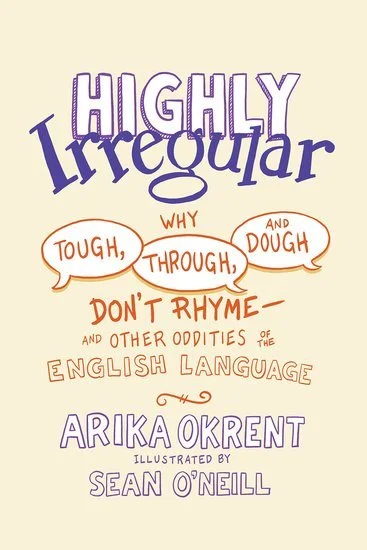Highly Irregular
Highly Irregular: Why tough, through and dough don’t rhyme – and other oddities of the English language
by Arika Okrent
A down-to-earth, informative and fun guide to the oddities of English
What it’s about
Highly Irregular is far more than just a ‘factoid’ list of the curiosities of the English language. Through explorations of the origins of various ‘oddities’ or ‘irregularities’ in English, Arika Okrent explains the main influences on English spelling and pronunciation, while also describing the inevitability of language change that threatens to undermine any fixed spelling system.
The examples are clearly explained, and are written in an accessible style that isn’t patronising. Explanations are interspersed with light-hearted cartoons by Sean O’Neill that reinforce the points in the text while raising a smile.
The ‘oddities’ are systematically chosen to highlight different influences on the history of English. For example, words that include ‘gh’ (e.g. tough, though, dough, light) are used to highlight Old English sounds that have fallen out of use, but are retained in our spelling system. The question ‘Why are there two ways to say the letter ‘g’?’ explores the influence of Viking invasions on spelling and pronunciation, while the pervasive influence of French is the focus when investigating why there are so many synonyms in English.
The best bit
The sensible, down-to-earth tone is refreshing. Arika Okrent explains the ‘irregularities’ of English through cultural influences (e.g. the status of Latin and Greek during the Renaissance), gradual changes in pronunciation (e.g. the Great Vowel Shift), and drifts in meanings of words (e.g. the use of literally as an intensifier). However, as she notes in the final section of the book, not everything can be neatly explained:
“We expect it [language] to follow rules and conform to logic. But we forget that it is also just something people do.” (p. 182)
“Correctness in language can be defined in relation to rules that are either tacit conventions or explicitly formalised prescriptions. Over time, because language is something people do, both kinds of rules will change.” (p. 183)
“When language changes, it’s never the whole system changing at once. It happens one piece at a time, and pieces don’t coordinate or even communicate with each other while they do this. Contradictions won’t be noticed until they’re already baked in. All languages have them. English, because of its history has a lot of them.” (p. 244)
This common-sense approach makes a change from some areas of theoretical linguistics that hunt for an overarching logical system that tries to compartmentalise and categorise every aspect of a language.
The takeaway
Highly Irregular is a very accessible starting point for understanding the history of the English language, and I recommend it to literacy teachers who want a gateway to understanding etymological influences on English spelling.
For such an easy-to-read book, it conveys some quite technical concepts, and the author’s in-depth understanding of language structure and language change help her to communicate ideas clearly. The range of examples is impressive, so even people with a good knowledge of the history of English will probably pick up some extra ‘titbits’ of information.

